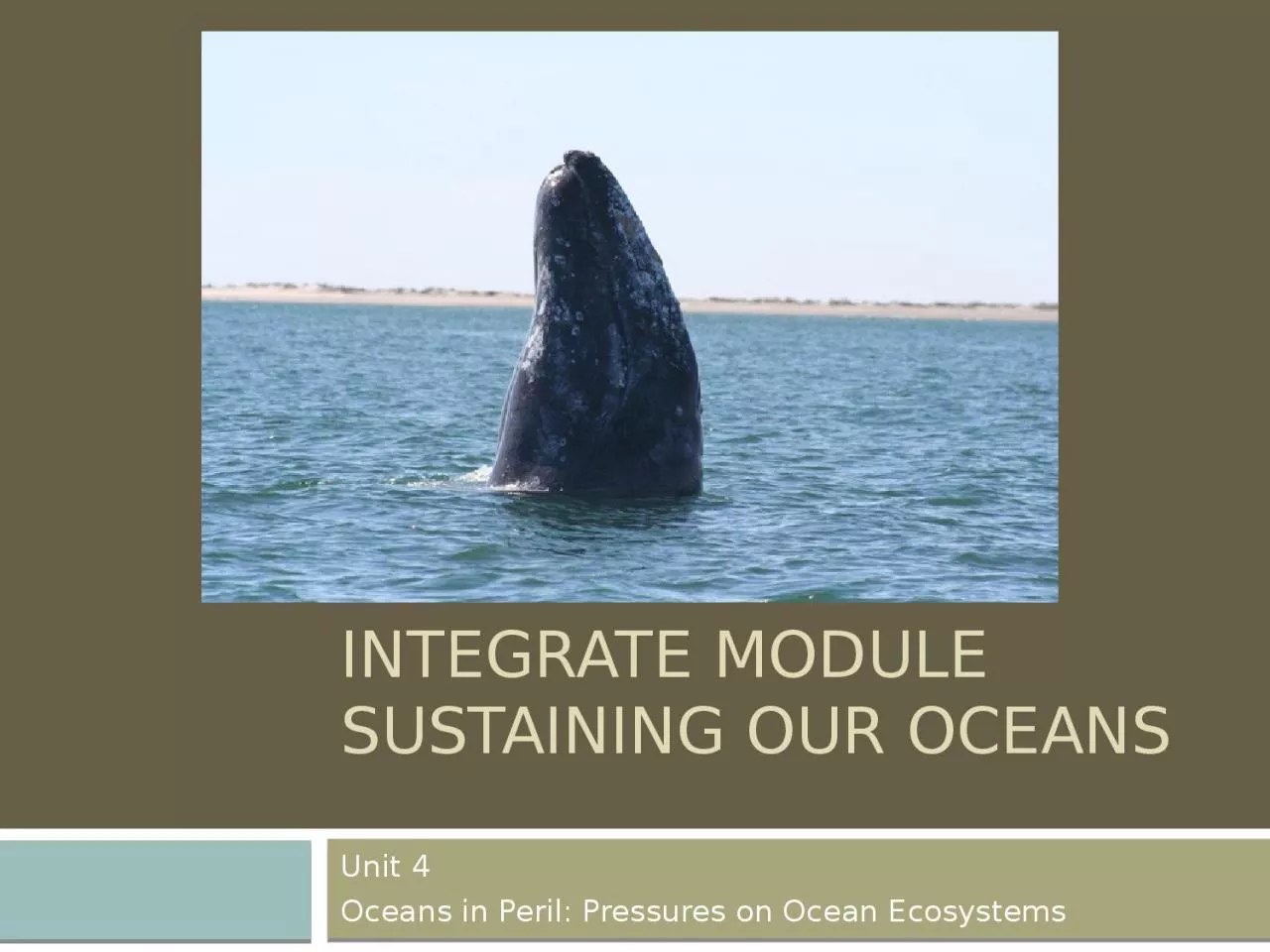

Unit 4 Oceans in Peril Pressures on Ocean Ecosystems Climate Change Studies Related to Oceans Evidence and Interpretation of Environmental Factors Increase In Ocean Temperatures Increase ID: 933774
Download Presentation The PPT/PDF document "InTeGrate Module Sustaining Our Oceans" is the property of its rightful owner. Permission is granted to download and print the materials on this web site for personal, non-commercial use only, and to display it on your personal computer provided you do not modify the materials and that you retain all copyright notices contained in the materials. By downloading content from our website, you accept the terms of this agreement.
Slide1
InTeGrate Module Sustaining Our Oceans
Unit 4Oceans in Peril: Pressures on Ocean Ecosystems
Slide2Climate Change Studies Related to OceansEvidence and Interpretation of Environmental Factors
Increase
In Ocean
Temperatures
Increase
In Global Sea Levels
Temperatures Rise
As reflective ice disappears, darker ocean waters absorb more heat
Arctic sea ice melts
Slide3Climate Change Studies Related to OceansEvidence and Interpretation of Biological Factors
Increase
In Ocean
Temperatures
Reduced habitat leads to food shortages
Temperatures Rise
As reflective ice disappears, darker ocean waters absorb more heat
Arctic sea ice melts
Reduced polar bear cub survival
Slide4Climate Change Studies Related to Oceans
Evidence and Interpretation of Biological Factors
Increase
In Ocean
Temperatures
Reduced habitat leads to food shortages
Temperatures Rise
As reflective ice disappears, darker ocean waters absorb more heat
Arctic sea ice melts
Reduced polar bear cub survival
Hydrosphere
Hydrosphere/
Cryosphere
Hydrosphere
Atmosphere
Biosphere
Hydrosphere/
Cryosphere
Slide5Gray Whale as Ecosystem Sentinel
What is an Ecosystem Sentinel?Animals that serve as an indicator of the health of the ecosystem.
Seabirds
and
marine mammals are conspicuous animals that integrate changes in the ecosystem and reflect the existing state of the environment (Aguirre and Tabor 2004;
Boersma 2008; Thiele et a1. 2004).
Slide6Gray Whale Global Distribution
Blue areas on map represent gray whale habitat for Western Pacific and Eastern Pacific populations. Labels provided for Western Pacific Stock indicating feeding grounds, breeding grounds and migratory routes.
Breeding Grounds
Feeding Grounds
Migration Route
Western
Pacific
Eastern
Pacific
Slide7The Gray Whale Life Cycle;
Migratory and Feeding Behaviors
Summer Feeding Grounds
– In higher latitudes,
g
ray whales feed from late spring to early fall.Fall Migration – Southbound whales travel to the breeding lagoons when ice forms in the Arctic, around November.
Mating and Calving Grounds – By January, most gray whales are occupying the breeding areas.
Spring Migration – Northward migration occurs from January through June.
Jan Feb Mar Apr May Jun Jul Aug Sep Oct Nov Dec
Winter Mating/Calving
Spring MigrationSummer Feeding
Fall Migration
Slide8Environmental Factors
Sea Ice:Reduction in sea ice allowsgray whales more access to
feeding grounds in
Arctic areas in the winter.
Following reduction in sea ice, greaternumbers of
calves were counted on northbound migration.
NASA and Natural Defense Council
Slide9Environmental FactorsPrey
Availability: Gray whales are opportunistic feeders and can shift their primary feeding grounds in response to prey densities.“I
suspect the gray whales will be among the winners in the great climate change
experiment.” UC Berkley
News Center http://newscenter.berkeley.edu/2011/07/06/gray-whales-likely-survived-the-ice-ages-by-changing-their-diets/
Slide10Environmental Factors
Regime Shift = a
major reorganization of biota in the northeast
Pacific, related to Pacific Decadal Oscillation.
The Pacific Decadal Oscillation (PDO) is a long-term ocean fluctuation of the Pacific
Ocean with cool and warm phases oscillated every 20–30 years.
During the 1970s warm phase, gray whales showed a one-week delay in southbound migration.
Slide11Environmental Factors
Warm El Nino and Cold La Nina extremesEl Nino is a disruption of the ocean-atmosphere system which causes ocean temperatures to increase by a few degrees.
Mothers and calves have shown changes in occupancy and departure time from breeding lagoons in response to the extremes of ocean temperatures correlated with El Nino Oscillation events in the Pacific Ocean.
Slide12Activity – Gallery Walk
2)
Station
Rotations
1) Evidence
2) Interpretation/Change In Environment3
) Category of Life Cycle4) Review and Comment
1) Group Assignment
Concept/Change in gray whale behavior Evidence
3) Group ReportOrally summarize evidence and interpretation for class at original station
Slide13Rotation 1 – Change in Distribution and/or Behavior of Gray Whale
List the evidence for this scientific study provided in the “Marine Mammals As Ecosystem Sentinels” article.
Slide14Rotation 2 – Interpretation Related to Climate Change
Propose a scientific reason for the scientific study provided to you in the last rotation. This
reason should be related to climate change, or interpretation for this noted
evidence.
Slide15Rotation 3 – Life Cycle Affected
Categorize the evidence and interpretation as to which part of the Gray Whale Life Cycle is most affected, feeding (wintering grounds), breeding (summering grounds),
or migration route.
Slide16Rotation 4 – Review Evidence and Interpretation.
1) Review the posts provided by the first 3 rotations.2) Agree or disagree with the evidence and interpretation.3) Note any changes in writing on the poster. Include comments, additional facts or evidence, or alternative interpretations.
Slide17Wrap Up/Summary
Slide18Station Design Template
Station
3
Feeding Year
Round
Evidence:Interpretation
:Life Cycle Stage:Instructor Labels Station Number and Scientific Study (Underlined)
Students fill in Evidence, Interpretation and Life Cycle Stage during rotationsStation 2Calf NumbersAnd Lagoon Occupancy
Evidence:Interpretation:Life Cycle Stage:Station 1Southbound
MigrationEvidence:Interpretation:Life Cycle Stage:
Station 4Gray WhaleCallsEvidence:Interpretation:Life Cycle Stage:
Four stations – poster paper taped to walls or places on flat tables around room
Center of room (wall posters version) or filled with table tops (larger groups)Screen/White Board
Slide19Sample Station Poster – Completed
Station 1: Southbound MigrationEvidence
: One-week
delay in
southbound migration, as noted by coastal whale countsInterpretation: Response to the late 1970s regime shift in the North Pacific
Life Cycle Affected: Migration